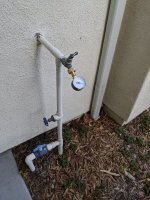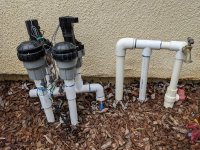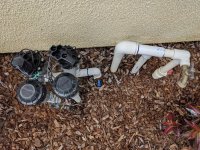wwhitney
In the Trades
Depending on the physics of water hammer, a different arrangement might be more effective. E.g. putting in a jog up and then back down on the horizontal water supply line (what you'd get with (4) 90's), and then changing the upper downstream 90 into a tee with a short vertical riser for a water hammer arrestor. That way the pressure wave would be directed at the water hammer arrestor, and only passes upstream through the tee side branch and the two upstream 90s.You'd install a tee in the water feed just upstream of the valve manifold, then a short riser to a water hammer arrestor.
Worth checking out, it should be a known thing.
Cheers, Wayne



